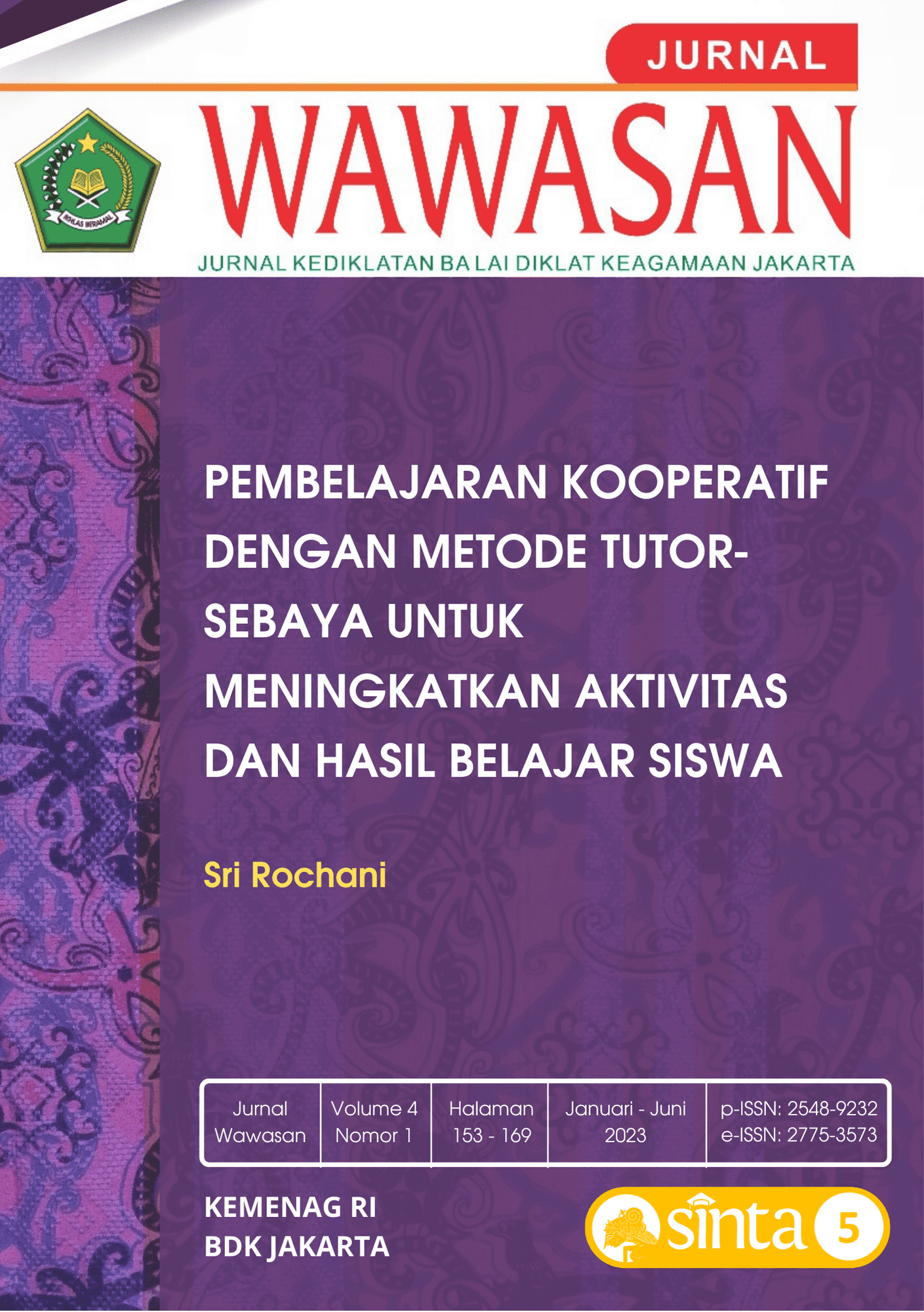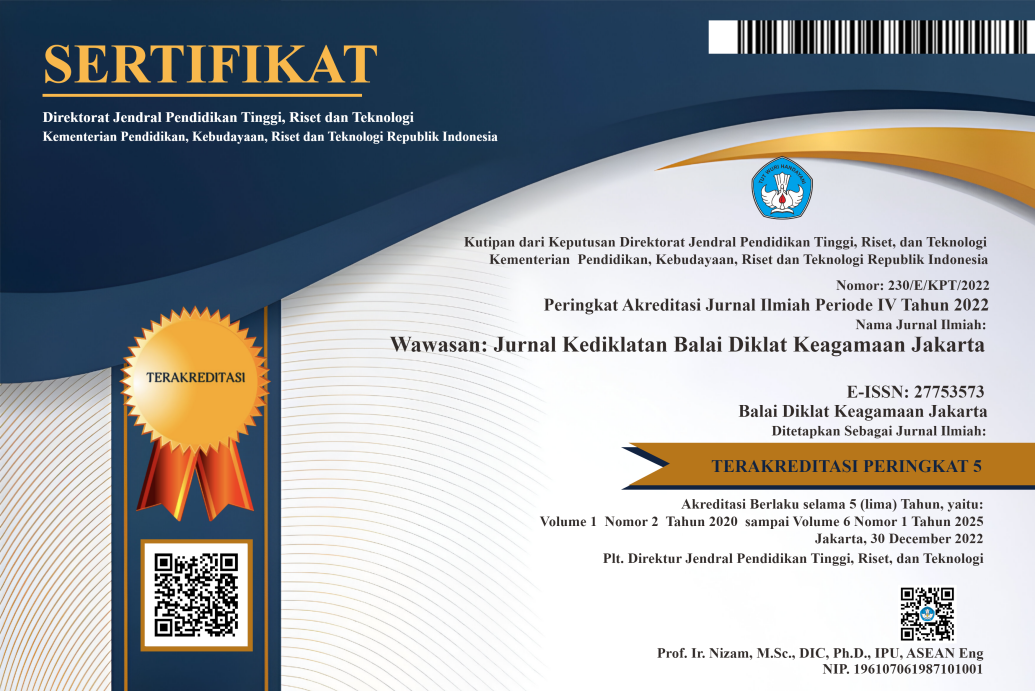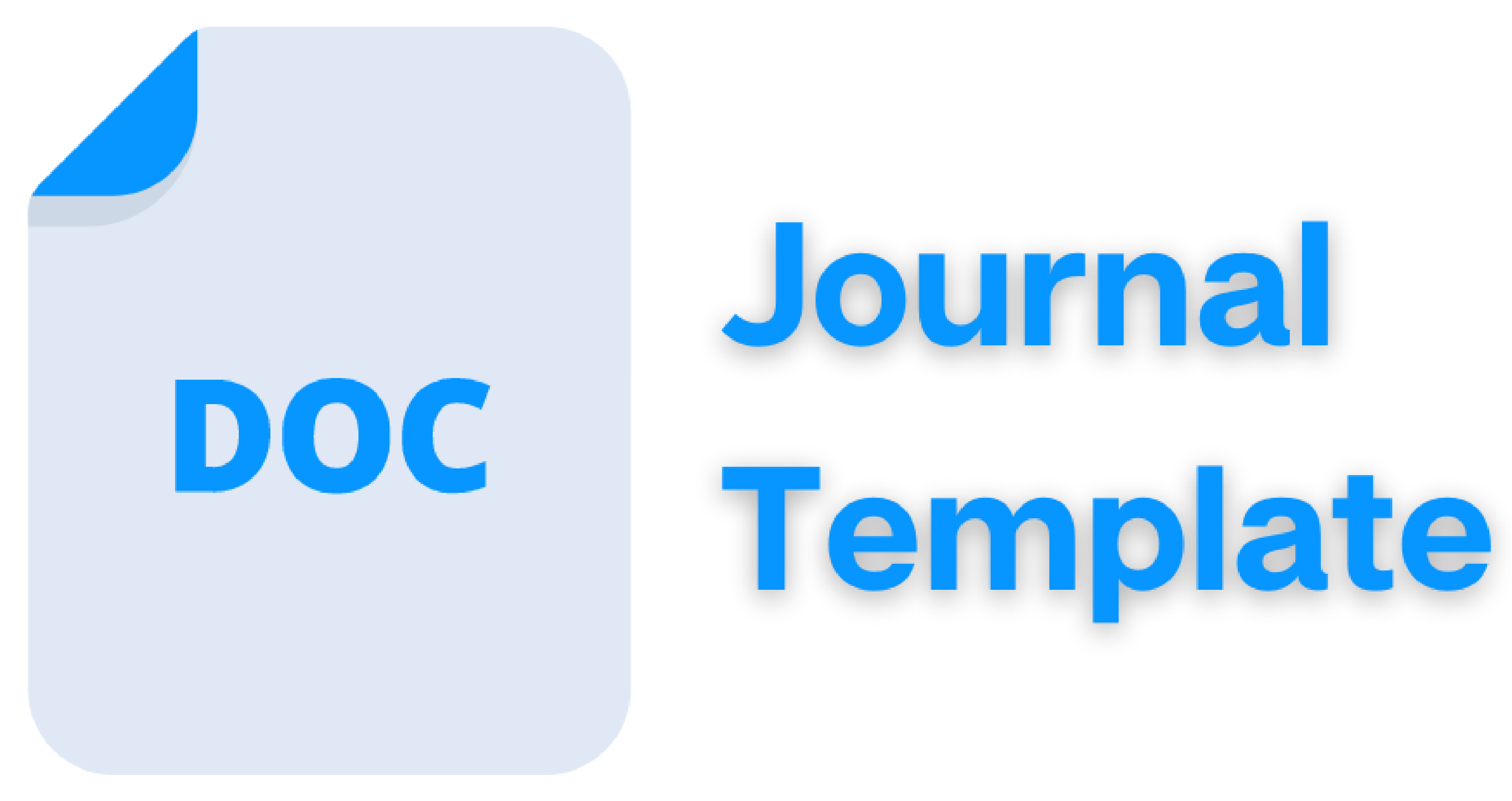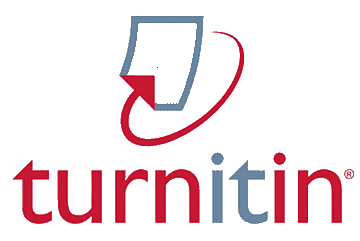PEMBELAJARAN KOOPERATIF DENGAN METODE TUTOR- SEBAYA UNTUK MENINGKATKAN AKTIVITAS DAN HASIL BELAJAR SISWA
DOI:
https://doi.org/10.53800/wawasan.v4i1.215Keywords:
penelitian tindakan kelas, tutor-sebaya, aktivitas siswa, hasil belajar, biologiAbstract
Abstract
This classroom action research aimed to describe how to apply the STAD model peer-tutor cooperative learning to increase student activity (asking, answering, arguing, and problem-solving) and biology learning outcomes. The results show that student activities experience dynamics during the implementation of activities. Asking activity is still the activity most students do compare to other activities. However, from a trend standpoint, the responding activity shows a steady uptrend. The activity pattern for answering is almost the same as for denying. However, the first upward trend is higher than the last; meanwhile, problem-solving activity fluctuated and tended to decrease. The possibility that can be interpreted in this problem-solving activity is to reduce the issues debated in the discussion. Study results show an increase in both cycles. This study's results align with the learning objectives of the peer-tutor model, which provides opportunities for students to develop their abilities and feel part of a group. This study concludes that cooperative learning with the peer-tutor method helps increase student activity and learning outcomes.
Abstrak
Tujuan penelitian tindakan kelas ini adalah mendeskripsikan cara menerapkan pembelajaran kooperatif tutor-sebaya model STAD untuk meningkatkan aktivitas siswa (bertanya, menjawab, menyanggah dan memecahkan-masalah) dan hasil belajar Biologi. Hasilnya menunjukkan bahwa aktivitas siswa mengalami dinamika selama pelaksanaan kegiatan. Aktivitas bertanya tetap merupakan aktivitas yang paling banyak dilakukan siswa dibanding aktivitas lainnya. Namun, dari sudut tren, aktivitas menjawab menunjukkan tren naik yang stabil. Pola aktivitas menjawab ini hampir sama dengan aktivitas menyanggah, namun tren kenaikan aktivitas yang pertama lebih tinggi dari yang terakhir. Sementara itu, aktivitas memecahkan-masalah berfluktuasi dan cenderung turun. Kemungkinan yang bisa ditafsirkan pada aktivitas memecahkan masalah ini adalah menurunnya permasalahan-permasalahan yang diperdebatkan dalam diskusi. Hasil belajar menunjukkan peningkatan pada kedua siklus. Hasil penelitian ini senada dengan tujuan pembelajaran dari model tutor-sebaya yang memberikan kesempatan kepada siswa untuk mengembangkan kemampuannya dan merasa bagian dari sebuah kelompok. Penelitian ini menyimpulkan bahwa pembelajaran kooperatif dengan metode tutor-sebaya bermanfaat untuk meningkatkan keaktifan dan hasil belajar siswa.
Downloads
References
Agusta, E. S. (2022). Peningkatan Kemampuan Penguasaan Konsep Matematis Dengan Modul Berbasis Numerasi. Wawasan: Jurnal Kediklatan Balai Diklat Keagamaan Jakarta, 3, 1–15. https://doi.org/DOI:10.15294/komunitas.v3i1.2303
Anas, M. (2014). Mengenal Metode Pembelajaran. Pasuruan: CV Pustaka.
Arifin, Z. (2017). Evaluasi Pembelajaran: Prinsip, Teknik, dan Prosedur. Bandung: PT Remaja Rosdakarya.
Bell, L. M., & Aldridge, J. M. (2014). Student Voice, Teacher Action Research and Classroom Improvement. Rotterdam: Sense Publishers.
Busemeyer, M. R., Lergetporer, P., & Woessmann, L. (2018). Public Opinion and the Political Economy of Educational Reforms: A survey. European Journal of Political Economy, 53, 161–185.
Dwiastuti, T. (2022). Peningkatan Kemampuan Baca Tulis Qur’an Melalui Penerapan Metode Tutor Sebaya. AL BAYAN, Jurnal Pengembangan Belajar Dan Pembelajaran Pendidikan Agama Islam, II, 166–175.
Fong, C. J., Davis, C. W., Kim, Y., Kim, Y. W., Marriott, L., & Kim, S. Y. (2017). Psychosocial Factors and Community College Student Success: A Meta-Analytic Investigation. Review of Educational Research, 87(2), 388–424. https://doi.org/10.3102/0034654316653479
Jamaludin, M., & Mokhtar, M. F. (2018). Students Team Achievement Division. International Journal of Academic Research in Business and Social Sciences, 8(2), 570–577.
Lo, C. K. (2017). Examining the Flipped Classroom through Action Research. The Mathematics Teacher, 110(8), 624–627. https://doi.org/10.5951/mathteacher.110.8.0624
Mustofa, A. (2022). Peer Teaching dalam Pembelajaran Sejarah Kebudayaan Islam Masa Pandemi Covid 19 di MA Al-Urwatul Wutsqo Diwek Jombang. ATTANWIR: Jurnal Keislaman Dan Pendidikan, 13(1). Retrieved from http://e-jurnal.staiattanwir.ac.id/index.php/attanwir/index
Nurdyansyah, & Widodo, A. (2015). Inovasi Teknologi Pembelajaran. Sidoarjo: Nizamia Learning Center.
Nurhasanah, L., & Gumiandari, S. (2021). Implementasi Metode Pembelajaran Tutor Sebaya Terhadap Hasil Belajar Siswa. Pedagogik: Jurnal Pendidikan, 16(1), 62–68. https://doi.org/10.33084/pedagogik.v16i1.1881
OECD. (2020). PISA 2018 Results: Effective Policies, Successful Schools Volume V. Paris: OECD Publishing.
Rusmiati Aliyyah, R., Rasmitadila, Rachmadtullah, R., Widyasari, Mulyadi, D., & Ikhwan, S. (2019). Using of student teams achievement divisions model (STAD) to improve student’s mathematical learning outcomes. Journal of Physics: Conference Series, 1175(1), 7–12. https://doi.org/10.1088/1742-6596/1175/1/012159
Santori, D., Ven, K., & Hennessey, K. (2019). Collaborative Exploration of Classroom Discourse. YC Young Children, 74(3), 1–23.
Sari, V. A. (2019). Educational Assistance and Education Quality in Indonesia: The Role of Decentralization. Population and Development Review, 45(S1), 123–154. https://doi.org/10.1111/padr.12272
Stephen Kemmis, McTaggart, R., & Nixon, R. (2014). The Action Research Planner: Doing Critical Participatory Action Research. Singapore: Springer.
Wahyuni, S. (2020). Peningkatan Motivasi Belajar Matematika Melalui Discovery Learning dengan Aplikasi Google Suite For Education. Jurnal Lingkar Mutu Pendidikan, 18(2), 216–226. https://doi.org/10.36765/jp3m.v2i2.36
Watson, S. B., & Barthlow, M. J. (2020). Action Research for Science Teachers. The Science Teacher, 87(6), 26–29. https://doi.org/10.7551/mitpress/9780262018555.001.0001
Wismath, S., Orr, D., & MacKay, B. (2015). Threshold Concepts in the Development of Problem-solving Skills. Teaching and Learning Inquiry, 3(1), 63–73. https://doi.org/10.20343/teachlearninqu.3.1.63
Zengin, Y., & Tatar, E. (2017). International Forum of Educational Technology & Society Integrating Dynamic Mathematics Software into Cooperative Learning Environments in Mathematics. Source: Journal of Educational Technology & Society, 20(2), 74–88.

Published
Issue
Section
License
Copyright (c) 2023 Wawasan: Jurnal Kediklatan Balai Diklat Keagamaan Jakarta

This work is licensed under a Creative Commons Attribution-ShareAlike 4.0 International License.

















